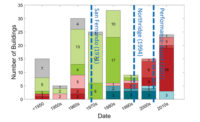... Klemencic. “A prescriptive design would have never identified this. [PSD] allows us to study the building with more rigor and put the strength and detailing where it does the most good or is required.”
 Webcor In performance core, rebar is thicker at the base, where it does the most work.
|
There were other surprises during engineering. Results of wind tunnel tests prompted the the addition of the rooftop damper midway through design. “The building is very lively,” says Klemencic.
It sits by itself on a hill with no shielding from wind and one face curves. As wind whips around the building from south to north, it creates a cross wind effect, causing the building to sway from east to west.
The damper consists of four concrete tanks equipped with baffles to absorb energy. The tanks have a total 50,000-gallon capacity. Water doubles as a supply for firefighters. MKA expects to finish determining the best water level by May.
 Webcor
|
 Webcor
|
MKA also fine-tuned the design based on tests of slab-to-core-wall connections at the University of California, Berkeley. In one configuration, post-tensioning tendon anchors were located one slab-depth away from the face of the core wall. The engineer also increased slab-bottom reinforcing to match top reinforcing.
Slab cracks were smaller and better distributed and the connection demonstrated more ductile behavior. “This configuration demonstrated substantially improved behavior,” says Klemencic. The tower uses the improved detail.
MKA made another adjustment to the design, this time involving congested link beam rebar above openings in core walls. Tests at the University of California, Los Angeles, showed that if required sets of diagonal bars are placed free of direct confinement and the overall beam section is confined similar to a column, the beams perform equally as well as the more traditional but nearly unconstructible approach (ENR 5/21/07 p. 10). The alternate detailing has been adopted into the American Concrete Institute’s model code, which is being released this week.
Unlike the adjustments, BRBs were part of the original concept. MKA chose BRBs over the more typical concrete outrigger walls because BRBs absorb a lot of energy in a more predictable fashion.
The tower, with a 90-ft x 110-ft footprint and 50-ft x 33-ft core, is slender for its height. The core’s aspect ratio is 18:1 in the long direction and 12:1 in the short direction. BRBs, which consist of steel sleeves containing steel cores coated with a debonding agent surrounded by concrete, reduce the aspect ratio to 8:1.
 Webcor Trussed flyers bear on columns.
|
Outrigger locations are based on the developer’s desired residential unit mix, the architect’s design and structural considerations. One system spans from level 26-32; the other from 51-55. Each system of 8 BRBs consists of two pairs of outrigger diagonals that form mirror image Ks. Each BRB diagonal, 18 to 20 ft long, spans two levels, The capacity of each of the 16 BRBs, design and fabricated by Star Seismic, Park City, Utah, is 1,200 kips. At the time, that was the largest tested BRB on the market.
Full tower height perimeter outrigger columns, 2 x 8 ft in one direction and 7 x 6 ft in the other, are reinforced concrete except for six stories at each outrigger system. There, MKA embedded a steel column that transfers loads from BRBs into surrounding concrete.
“In addition, the purpose of the steel column was to aid the contractor installing the gigantic steel connection plates the BRBs are attached to,” says Ola J. Johansson, MKA’s project manager.
Plates were shop-welded to the embeds, he explains. On site, the assembly was lifted in place inside the outrigger column. “This helped to locate the plates with...


